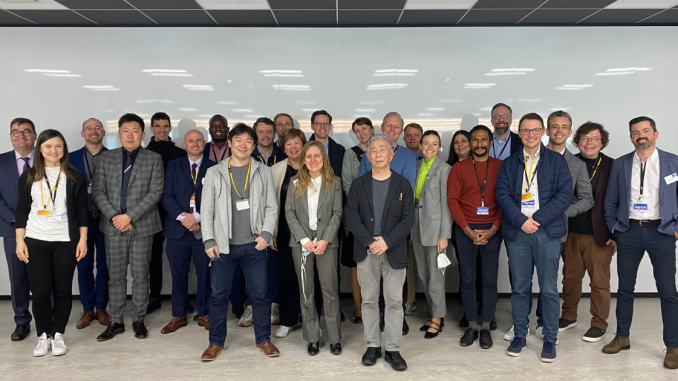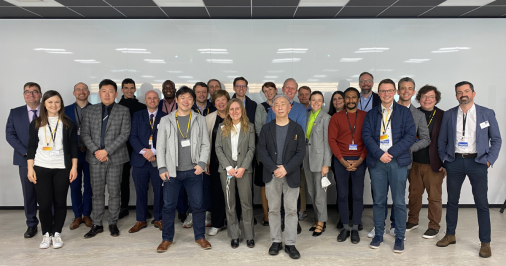

I’m back from the cave, feeling refreshed, educated, and happy, with plenty of time on my hands. As you might have guessed, I’ve just submitted my master’s thesis. We’ve also recently returned from Japan, where we attended the International Field Seminar (IFS). I have lots of exciting information to share!
Master’s thesis
In my last article, I mentioned that I had the opportunity to choose between the thesis or the project. The school gave us the option, but if we didn’t have a project at work that we could work on, we were required to do the thesis.
At first, I was hoping to do a project, but now that I have finished my thesis, I am incredibly happy that I did it. The thesis was more than just an assignment for me; it was my first academic paper. You may know my story and that I used to be a craftswoman. However, I wanted to develop my skills beyond manual work. I was keen to learn, grow, and develop in the theoretical aspects of it. My true passion lies in transformation and improvement.
Finding the topic
When I chose the topic, I spent a considerable amount of time researching the subjects and the questions I wanted to answer within the thesis. I had to find a question that wasn’t too broad so that I could back it up with theory and my respondents could answer all the questions.
I had to bear in mind the maximum number of pages for the paper, as well as whether I wanted to make my life easier by choosing a topic with accessible data or a topic that I was particularly interested in but would require more effort to collect data. I wanted to focus on the strategies of companies, but I found it difficult to get enough data for it, as some CEOs were unwilling to discuss the topic and many of them had no time.
Structure of the thesis
I won’t go into detail on all the topics, but I want to give you some thought-provoking points to consider.
- Finding the literature which tells a story and underlies your research is crucial. It is important to show that you understood the topic and that you know how to reference and find academic papers.
- Check what kind of methodology you can use and define how you will structure the paper. Do you have numerical data, and can you use quantitative analysis? Will you perform interviews and deep dive into the questions, so you can perform a qualitative analysis? Maybe you are also taking a mixed approach. Regardless, consider the methods and procedures you will use to collect and analyze data carefully.
Searching for data
I was highly motivated to begin a quantitative analysis. I planned to conduct a quantitative analysis and then supplement it with additional interviews. To this end, I created a questionnaire and shared it with a group of over 30,000 people.
Surprisingly, I only received one response. I started to think that perhaps the way I had framed the question was the issue. Therefore, I revised the question three times – once with more personal information, once by highlighting the potential benefits for CEOs, and once by including an eye-catching image to attract more attention. Still, this didn’t help. I also provided incentives, like sharing the survey results or offering vouchers, but this too was to no avail. I put a lot of thought into ways of encouraging more responses, but nothing worked.
In addition, I:
- Contacted insurance companies to request data
- Shared my questionnaire with all dental chambers in Germany
- Shared the questionnaire with my contacts
- Asked family and friends to go to their dentists (yes, I had dentists in my focus group) with a printed copy of the questionnaire
- Reached out to my contacts for the second time
I felt desperate to get something valuable out of my efforts. With only 13 days before the deadline, I lay in bed feeling frustrated. I had worked so hard, yet I only had six or seven responses, which wasn’t enough for a quantitative analysis.
Just when I was feeling defeated, the survey app I was using suddenly popped up with 56+ new responses – I was both confused and overjoyed. I couldn’t believe it, so I updated the app twice, and guess what, it still showed me 56+ new responses. I wanted to jump out of bed with joy but then came the realization of what that meant for me. I had to ask myself if it was too late – 13 days to perform a quantitative analysis, and rewrite my methodology and results. But I decided to go ahead with it.
Key learnings
I learned that you need to be mindful of the questions you pose and how you phrase them. In the end, I had some questions that I had to analyze with tools outside of Excel, which was difficult to do in the 13 days I had left. Watching videos that were mostly 30 minutes of unimportant dialogue with only 10 minutes of valuable content was really painful. Thankfully, I have friends who could explain it properly.
The whole process of writing my master’s thesis taught me a lot, and I hope I can apply that to blogging or business life in the future. I actually enjoyed reading the papers, and I now know how much effort goes into them. Especially if someone does it part-time.
International Field Seminar
In case you skipped the first part, just to summarize, it was really a lot to do, and I was finally prepared for vacation. But of course, the IFS is not vacation and it was never meant to be a vacation.
We needed to prepare our goals for it. So, either someone from my first study group (Meitner) had to organize a company visit before a specific deadline, or we had to do a country or city presentation. If you’ve read my previous articles, you’ll know I tend to go for both options. Our group did the country presentation, but at the same time, I was already preparing a company visit with Fujitsu.
How to organize a company visit
You either need to know how to approach the people in the country you are visiting or have contacts to who you can reach out to. I was able to organize a company visit by reaching out to my incredible network who helped me secure the visit. If you don’t have contacts, start your research focusing on the country you are visiting to help you understand the common ways to approach a business.
We were lucky and were able to visit a couple of companies during the IFS, despite one of the challenges we faced which was room capacity. Tokyo is known for its small apartments, small hotel rooms, and guess what, small meeting rooms in companies. Many of the companies struggled to find a space to accommodate 47+ people.
That’s why we needed to plan two visits at the same time. Our class was split, but I managed to visit: DHL, KDC, BNI, Allianz, Bosch, KPMG, Fuji Electric, Evonic, and Fujitsu. We were able to learn about the businesses, furthermore the culture, and in particular, what it is like to work in Japan. For example, your hierarchical position in Japan tells you something about the position where you need to stand in the elevator. I am not sure how often I got the CEO position in the elevator, or just the apprenticeship position. But it was interesting to see how that works. I stood out with my blond hair so I’m sure I wasn’t expected to follow the Japanese hierarchical rules, at least not in that way. Japanese people are extraordinarily nice and polite.
Fujitsu company insights
The company had full control over preparing the content. They knew, of course, who we were and what we were doing, but we were open to receiving any business-related content. What Fujitsu did was different from the other company presentations we experienced. They split it into a business terms part related to Fujitsu Uvance and the theoretical part performed by a professor.
My classmates asked me how I managed to even get a professor within the session. I’m too honest so I will let you in on the secret, I didn’t do it, it was the Fujitsu team who put such considerable value into the academic perspective. We were really impressed!
Not only did we get fascinating and, in my opinion, open presentations (in comparison to other Japanese companies) about Fujitsu but also a theoretical perspective that underlines the practical actions. I think the company gained plenty of fans after the presentations. And if you think a large corporate is not agile, please take a look at Fujitsu!
Now, I am taking two more SNOC courses, creating a group video presentation about our key learnings from the IFS, and investing time in my hobbies.
